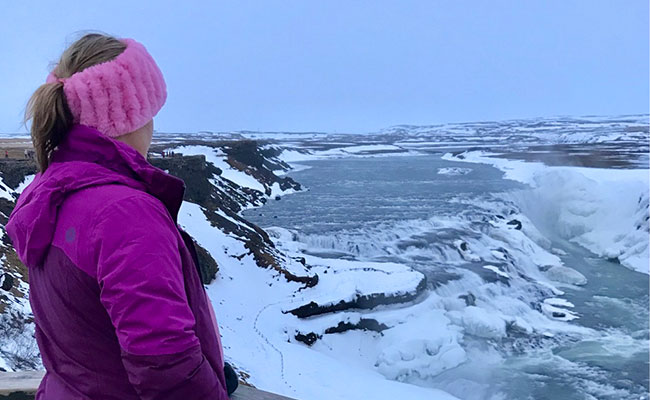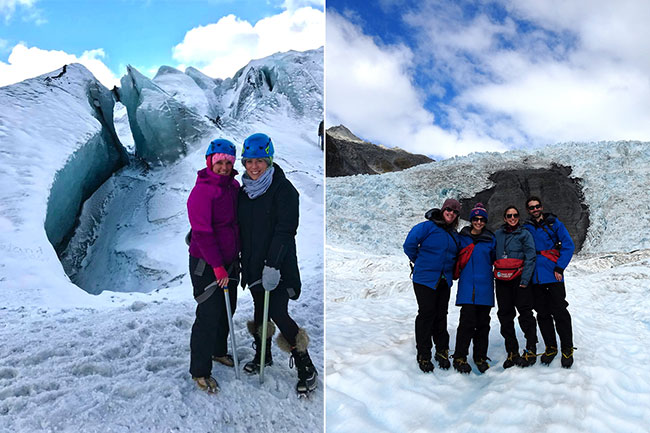Why New Zealand vs Iceland?
I was recently reminiscing about my trip to Iceland and thought I would tell you a bit more about it. I would say that Iceland is very comparable to New Zealand in the types of activities that are available. Both are worth a visit but read below for the most important differences between the two.
I made a trip to Iceland in 2018. At that time, it was a new destination for us at Down Under Endeavours, so I was intrigued by everything I had heard about this small island. Known for glaciers, geysers, and hot springs, it almost sounded like a mini New Zealand! My top reason for traveling to Iceland was to see the Northern Lights, but I was also interested in seeing how this destination would stack up to New Zealand, one of my favorite places in the world.
The bottom line is both destinations are amazing for your dream trip with your family or for a special occasion. However, I did find several similarities between Iceland vs. New Zealand, but there were some key differences as well.

Icy waterfall at Skalakot in Iceland
The Flight
The biggest difference is the time! To fly to New Zealand, you have lots of options: Air New Zealand, American Airlines, Qantas and United all fly from the US to New Zealand. The flight time from LAX is about 12 hours, so I would recommend a premium economy or business class seat. Your flight to Iceland is only 5-7 hours, depending on where you are flying from in the US. Iceland Air is the main carrier, and they do offer three cabins of service. Additionally, the airline has many connections to Reykjavik from the US. However, Iceland Air doesn’t stand up to the service and quality of an Air New Zealand flight.
Nature and Experiences
Both countries are stunning. New Zealand offers a wide variety of landscapes from mountains to green rolling hills to beautiful seaside villages. I would recommend carving out at least 2 weeks in New Zealand to give yourself time to immerse yourself in the country and get a chance to see the Southern Lights. New Zealand has many attractions—glaciers on the West Coast, volcanoes, and interesting geothermal attractions in Rotorua; fascinating glowworm caves in Waitomo; plenty of waterfalls in Milford and Doubtful Sounds; and black sand beaches around Auckland. You can go diving at Poor Knights Island without a dry suit.
Iceland also has a lot to offer: glaciers, lava caves, volcanoes, waterfalls, black sand beaches, geysers, hot springs, and lots of natural beauty. It is a relatively small island, and I found that 8 days was plenty of time to explore everything I wanted to see. In Iceland, highlights are the Golden Circle (Thingvellir National Park, The Geysir Thermal Area, and Gullfoss Waterfall), which is easy to do in one day from Reykjavik. You can go diving in the Silfra Fissure (between tectonic plates), however, you do need to be dry suit certified.
Both countries lend themselves to self driving. However, New Zealand is an easier country to navigate and you stand less of a chance of icy roads. Driving in Iceland can be treacherous.

Left: Me hiking on a glacier in Iceland. Right: Some of our clients hiking on a glacier in New Zealand
Weather
Both countries are affected by the weather. There is no wrong time to visit New Zealand. In their winter months (June, July, and August), you will be limited in some areas, and some of your scheduled activities may be canceled due to weather.
I traveled to Iceland in the middle of winter (February), as this is the best time to see the Northern Lights. But based on my experience, I would recommend traveling to Iceland between March and October. If you travel during our summer, the weather is quite temperate in Iceland, and you do get light 24 hours a day!
Northern Lights vs. Southern Lights
Both of them are a challenge to see, conditions have to be perfect. Clear night and no light pollution. The best time of year to see the Southern Lights in New Zealand will be the winter months, June-August. You will need to be sure to be as far south in the country as possible, Queenstown, Dunedin, Invercargill or best is Stewart Island. The key difference is that the Southern Lights are a less touristy attraction in New Zealand. The best time of year to see the Northern Lights is the winter months October to March. And again, you will need to be outside of Reykjavik. But there are LOTS of big buses that take you outside of the city to see the Northern Lights, very touristy!
Expense
While the flights to New Zealand will be more expensive than those to Iceland, New Zealand is more budget-friendly once you land. New Zealand being a bigger country also has a wide variety of accommodations, lending itself to all kinds of budgets. Iceland is a VERY small country therefore accommodation choices are limited and that translates to more expense. Meals and land arrangements in Iceland can be pricey, so just be mindful of your budget for meals and such. A trip to Iceland for 8 days will likely be as much if not more than a 12-14 day trip to New Zealand.
Iceland vs. New Zealand
At the end of the day, I am so glad I visited Iceland and saw some of the spectacular scenery here, as well as the Northern Lights (although I wasn’t aware that in real life, your naked eye doesn’t capture those bright greens and pinks you see in the photos—it’s more of a white glow). But my heart is in New Zealand, such an amazing country, I would highly recommend it for your next trip.
I would love to chat with you about traveling to Iceland vs. New Zealand! Give me a call at (312) 951-8517, and be sure to ask for Shannon.